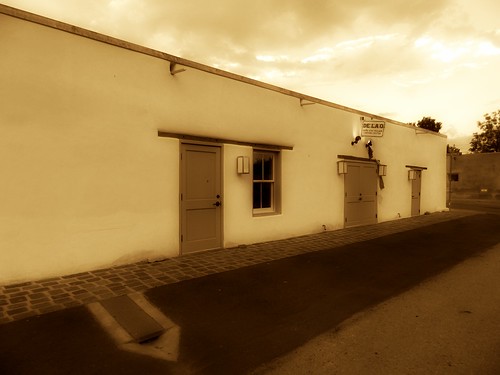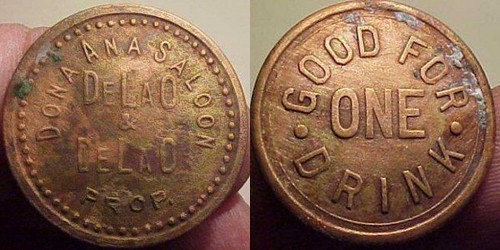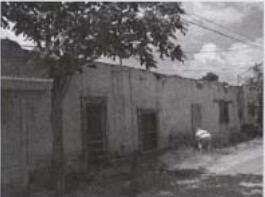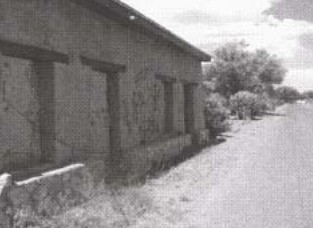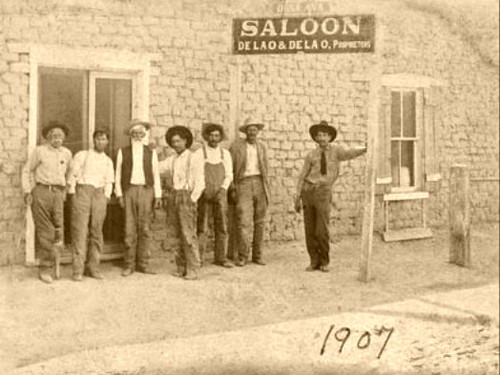Top: Another view of the De La O Visitor Center in the village of Dona Ana in New Mexico, formerly the De La O Saloon, also a front and back view of the tokens that were used at the saloon. Below: Two photos of the Saloon/Visitors Center before the renewal project.
Showing posts with label The De La O Saloon. Show all posts
Showing posts with label The De La O Saloon. Show all posts
Saturday, April 21, 2012
Wednesday, August 31, 2011
Heading to New Mexico
Jeri and I are headed for New Mexico. Tomorrow we will stop at Phoenix, Arizona and then it's on to Las Cruces, New Mexico where we will be visiting with our cousins, Louie and Rocky Burke and their mother Elba.
We'll also visit my cousin Tony Garcia of Silver City. The Hatch Chile Festival is also taking place on Saturday and Sunday, so I will definitely be getting my green chile fix this weekend. Another scheduled stop is the De La O Saloon and Visitors Center in nearby Dona Ana.
I will also meet the other Randy James De La O, who lives in Las Cruces, and who, by the eeriest coincidence also shares the same birthday, May 8th, with me, and last but certainly not least, after communicating for several years via email, cousin Juanita De La O Gordon and I will finally meet.
New Mexico has always been near and dear to my heart and I'm really looking forward to this trip!
We'll also visit my cousin Tony Garcia of Silver City. The Hatch Chile Festival is also taking place on Saturday and Sunday, so I will definitely be getting my green chile fix this weekend. Another scheduled stop is the De La O Saloon and Visitors Center in nearby Dona Ana.
I will also meet the other Randy James De La O, who lives in Las Cruces, and who, by the eeriest coincidence also shares the same birthday, May 8th, with me, and last but certainly not least, after communicating for several years via email, cousin Juanita De La O Gordon and I will finally meet.
New Mexico has always been near and dear to my heart and I'm really looking forward to this trip!
Thursday, March 17, 2011
De La O Saloon Token

De La O Saloon Token "Good for one drink"
DE LA O & DE LA O PROP.
Dona Ana, New Mexico (Dona Ana County), U.S.A.
Courtesy of Tokencatalog.com
Tuesday, March 15, 2011
Monday, March 14, 2011
De La O Visitor Center in Dona Ana, New Mexico Opens
Article and Photos Courtesy of Explore! New Mexico Blog
Doña Ana Poised For Future as Tourist Destination
The wagons churned along the Rio Grande over El Camino Real, advancing only a dozen miles or so each day. Travelers stopped at camps or parajes between Mexico City and Santa Fe. Most of those camps are distant memories, lost in the shifting sands of the desert and the changing course of the river. One of the camps has persisted into the 21st century. We know it as the village of Doña Ana.
On January 15, State Senator Mary Jane Garcia hosted the grand opening of the De La O Visitors Center in Doña Ana, culminating many years’ work of the many descendants who claim the name De La O and creating a focal point for community activities and tourists.
During the festivities, Sen. Garcia asked a show of hands of those who have come from the original De La O family. The senator is cousin to many of the village’s residents. She pointed to one man and asked if he was De La O, to which he concurred. Said the senator, “I’ve known you 20 years and didn’t know you were De La O. Hello, cousin!”
Those attending the grand opening included Las Cruces Mayor Ken Miyagishima, several Las Cruces City Councillors,representatives of Doña Ana County government, and other dignitaries. Unlike most other similar events, this one had the festive appeal of a family reunion.
Doña Ana dates to the late 17th century. The village, if it could have been called that at the time, was abandoned throughout most of the 18th century. According to Robert Julyan in his book, “The Place Names of New Mexico,” the governor of Chihuahua created the Doña Ana Bend Colony Grant to alleviate crowding in El Paso. But it was not settled until 1843 when Bernabé Montoya led thirty-three settlers to the site. They named their settlement after the semi-legendary Doña Ana, who may have been Ana Robledo who had fled south during the Pueblo Revolt, or Doña Ana María de Córdoba, whose ranch was nearby.
Whoever the name honored, settlers were determined to remain in their village, to farm and to thrive. El Camino Real ran through the heart of the village. It brought not only travelers and trade but also bandidos. It was also prey to marauding bands of Apache. But it persisted.
Between 1845 and 1850, a decade before the village of Las Cruces was laid out, villagers built a church. It was about a hundred feet long and twenty feet wide. Its adobe walls were three feet thick and its windows high to prevent Indians and bandits from shooting at people sequestered there. Candles in chandeliers and sconces between the Stations of the Cross dimly lit the church. A single clerestory window above the nave close to the apse let in the early morning light to illuminate the altar during Mass.
During the Civil War, De La O opened a saloon about a hundred yards south of the church. Just north of the saloon, Werthheim opened a general store, and north of that was the residence of the Cavello family.
Those buildings have persisted into the present time, but barely. In the late 1970s, the church was about to be condemned and demolished. The adobe buildings down the street had faired better, perhaps because of their boxy single-story construction. The structures seemed destined to melt into history just as old adobe returns to the earth.
But the community, led by Sen. Garcia, had other plans. Over a decade, Doña Anans, including some at-risk youth, rebuilt the church. They made more than 17,000 adobe bricks to reconstruct one wall which had collapsed and to shore up other parts of the building. Using a design of local artist Jeannie De Lo O Carbajal, who designed the art adorning the I-25 underpass at Highway 320, artisans in Mexico built a new altar patterned on the original which had deteriorated too far to reclaim. They retained the church’s original vigas and corbels and conserved the original French paintings of the fourteen Stations of the Cross. The church today is used for special occasions, including baptisms and marriages.
Then restoration work shifted down Camino Real, which for nearly two decades has been called Cristo Rey, to the old saloon and adjacent buildings.
The L-shaped De La O saloon has been restored with two meeting rooms and the mirror-backed bar, just as it might have looked 150 years ago. Its adobe has been painted white and its walls hung with historical scenes of the village of two centuries ago. Behind the building is a brick placita with fountain, stone planters, and shade trees. The community now has a facility for activities, celebrations, and fiestas.
As funds permit, the Werthheim building will be restored as a mercantile museum and the Cavello house will become the site of a farmers’ market.
For those who think Camino Real is nothing more than two ruts in the desert, come to the village of Doña Ana and see what family can do.
If you’d like to see the restored historic buildings and walk along part of the original royal highway, take Exit 9 off I-25 and turn south on Thorpe Road (NM-320). At the modern Catholic church, Our Lady of Purification, turn left onto Dusty Lane, which bends around the church and becomes Cristo Ray Street.
Subscribe to:
Posts (Atom)
